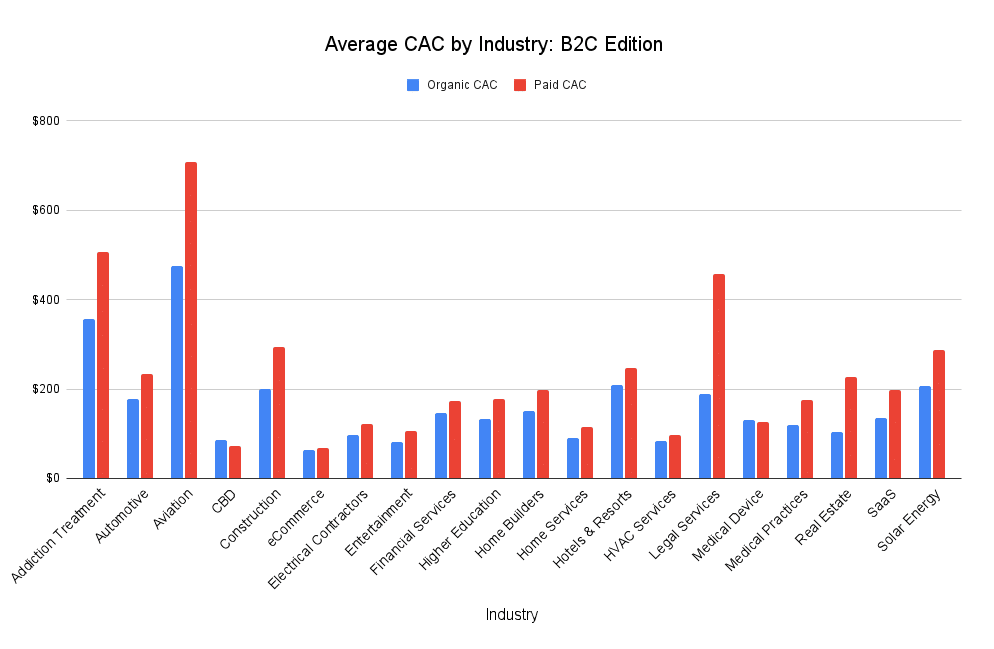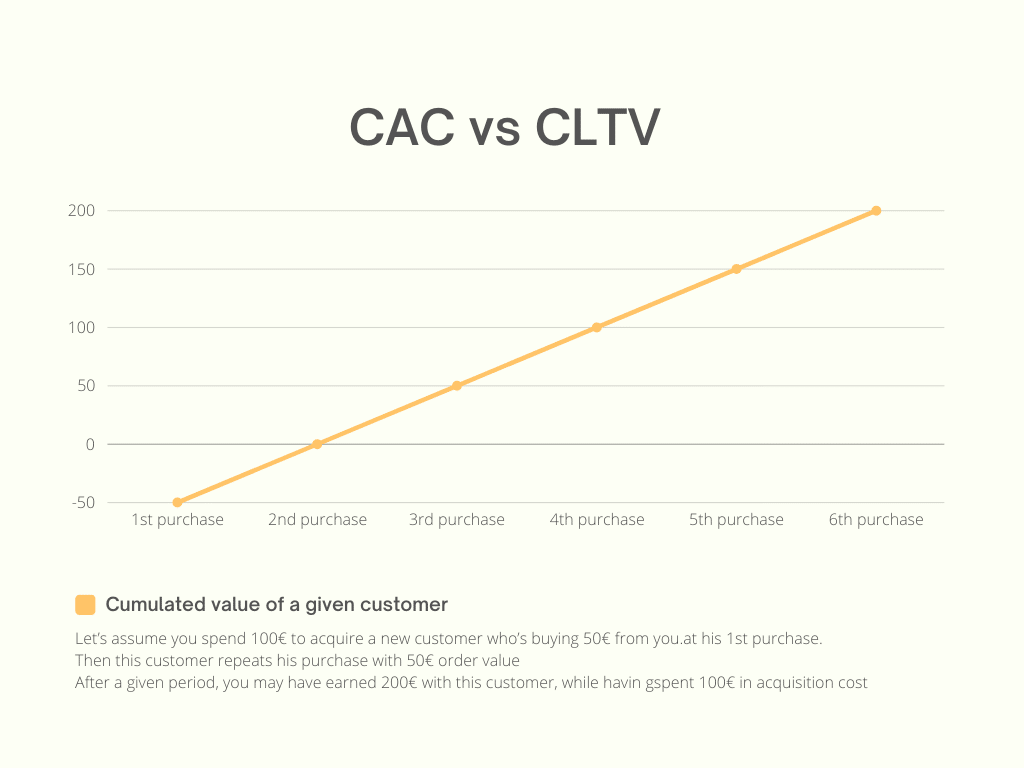We’re just finishing the Black Friday Cyber Monday (BFCM) period and jumping into the Christmas rush. For some of you, you might be celebrating your sales growth and juggling with the peak period until the last weekend before Christmas.
But for sure, you’ve also struggled with increasing online acquisition costs.
A few years ago, Black Friday started as a one-day sale where customers had one chance to grab huge deals online. Slowly over the years, this event extended to the entire weekend, then a week. As online competition keeps on increasing, most retailers, eTailers and DNVBs grab any occasion they can to boost acquisition and sales. For the last two years, we now see BFCM happening on the entire month of November. We’re now talking about “Black November“.
No doubt acquisition costs keep on (and will keep on) increasing.
As a brand, how can you avoid being trapped between the difficulty and the cost to acquire new customers and your ability to grow and thrive ?
Here are some concrete tips.
What is Customer Acquisition Cost ?
Let’s first make sure we all speak the same language. Back to basics: what is Customer Acquisition Cost ?
Your Customer Acquisition Cost, or CAC, is the amount of money you spend to acquire a new customer or client.
Online, it means the amount of Marketing and advertising expenses divided by the number of new customers.
CAC = Total Marketing and Advertising Expenses / Number of New Customers Acquired
I would advise you consider your CAC over a long and representative period, for example 12 months.
As your total Marketing and Advertising expenses, you can add
- Your paid search costs (Google Ads, Microsoft Ads, Meta ads…);
- Your display and RTB costs (Criteo…);
- Your SEO-related and content creation costs (Copywriter, translation…);
- Your content propagation costs (Outbrain, Taboola…);
- Your PR costs;
- Your Social media costs (Creatives, videos, community management…);
- Your tools and licence costs (Brevo, Klaviyo…);
- Your headcount costs (employees, freelance, agencies…).
And simply divide by the number of New Customers over the same period.
You’ll get your KPI, in € per customer.
If you spent $5000 to acquire 100 customers over the last 12 months, it means your CAC is $50.
To determine whether your CAC is good or bad, look at your industry benchmark:

Source : First Page Sage
Obviously, CAC in B2B industries are much much higher than CAC in B2C industries.
So why CAC keeps on rising online ?
It’s no secret CACs keep on (and will keep on) rising.
If you’re working in the digital space, you may have experienced it, and hopefully you take it into account when building your yearly budget and projections.
Why are CACs increasing year-on-year ?
- Increasing competition : especially since COVID, most brands have now initiated their digital transformation and try to sell their products and services online. The higher the competition, the higher the advertising costs to capture visibility and qualified traffic. As an example, your Cost per Click may increase YoY on Google Ads. Brands now need to raise their expertise and their ability to master digital ad campaigns to mitigate this point.
- Increasing Ad blindness : customers being over exposed to advertising on a daily basis, they tend to put lower attention to advertising. Brands trying to increase ad pressure will see their CAC increasing substantially. A best practice is definitelly to capture organic traffic with added-value content (ex. by answering to the problem your target audience faces).
- Increasing constraints due to privacy concerns : the upcoming phase-out of third party cookies, privacy regulations and iOS14 opt-out tracking policy will make it more complex to track ad performances and optimize your ad strategies. To balance this this, digital marketeers have no other choice but to build highly relevant ads creatives and messaging.
- Rising customer expectations : customers now expect exceptional and personalized experiences. They want to engage with meaningful brands which are able to create bonds and meet their values and hidden expectations. More than ever, brands must rethink their DNA, their values and their promises through design thinking approaches, test and learn and agile improvements.
Always consider your CAC along with your Customer Lifetime Value (CLTV)
Considering your CAC alongside your Customer Lifetime Value (CLTV) is essential for a comprehensive understanding of your overall marketing strategy.
These two metrics should always be analyzed together.
The Customer Lifetime Value (CLTV) is the total value you may expect from a given customer. It can be calculated as follow:
CLTV = (Average Purchase Value × Average Number of Purchases per Year) × Average Customer Lifespan
- Average Purchase Value is calculated by dividing your company’s total revenue in a period by the number of purchases in that period.
- Average Number of Purchases per Year is the total number of purchases divided by the number of customers in the same period.
- Average Customer Lifespan is the average number of years a customer continues purchasing from you.
The more a given customer will buy from you and the longer you will keep him as a customer, the more you can afford to spend to acquire this customer.
Even though your CAC is an important expense, and you may lose money at the first purchase, you may end up with a high CLTV if you keep the customer loyal.

Let’s assume you spend 100€ to acquire a new customer who’s buying 50€ from you.at his 1st purchase.
Then this customer repeats his purchase with 50€ order value.
After a given period, you may have earned 200€ with this customer, while having spent 100€ in acquisition cost.
So now what’s next ?
Now that you got those metrics for your business, you can refine your strategy and decide what is the maximum CAC you can afford.
- ACTION 1. Tell your digital Marketing team so they can tailor their digital acquisition strategy based on this max CAC.
- ACTION 2. Track your CAC per acquisition channel and add it into your dashboard
- ACTION 3. Make sure your CRM can track the CLTV as per your customer segmentation. You may calculate your CLTV based on historical data or leverage machine learning to predict CLTV per customer groups. You may also leverage field calculation depending on the CRM you have.
- ACTION 4. Rethink your customer experience to maximize purchase frequency and average order value.
- ACTION 5. Sit with your finance partner, forecast your loyalty-based revenue and estimate the gap with your sales target. You’ll then be able to estimate the amount of new customers you need to acquire for the next fiscal year
